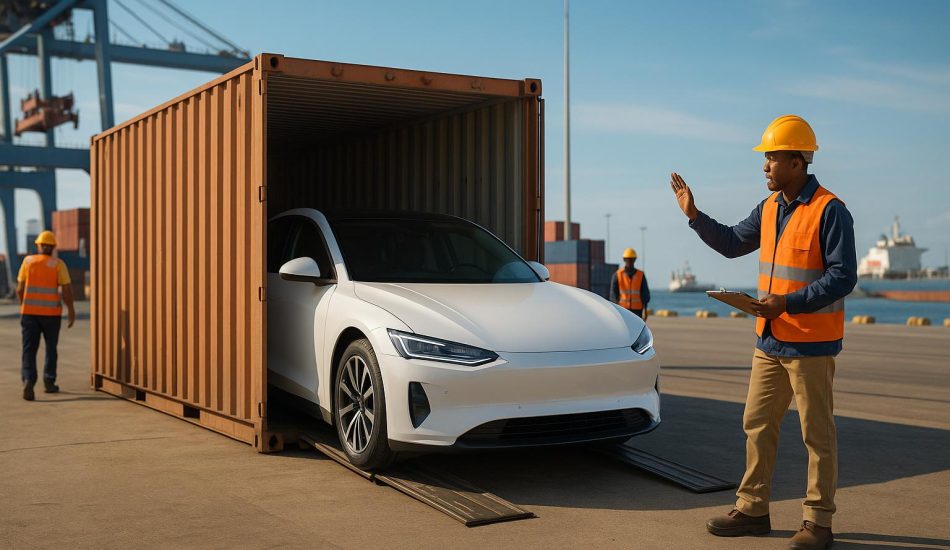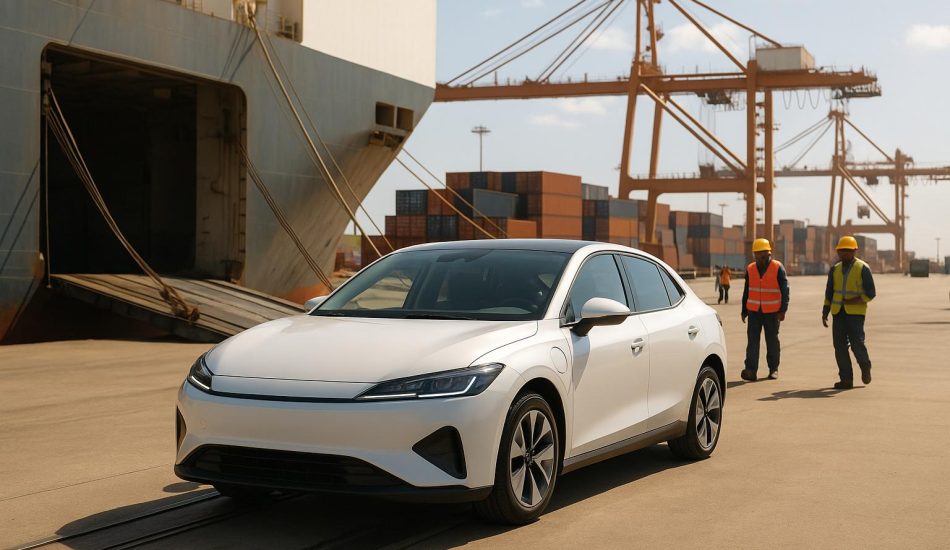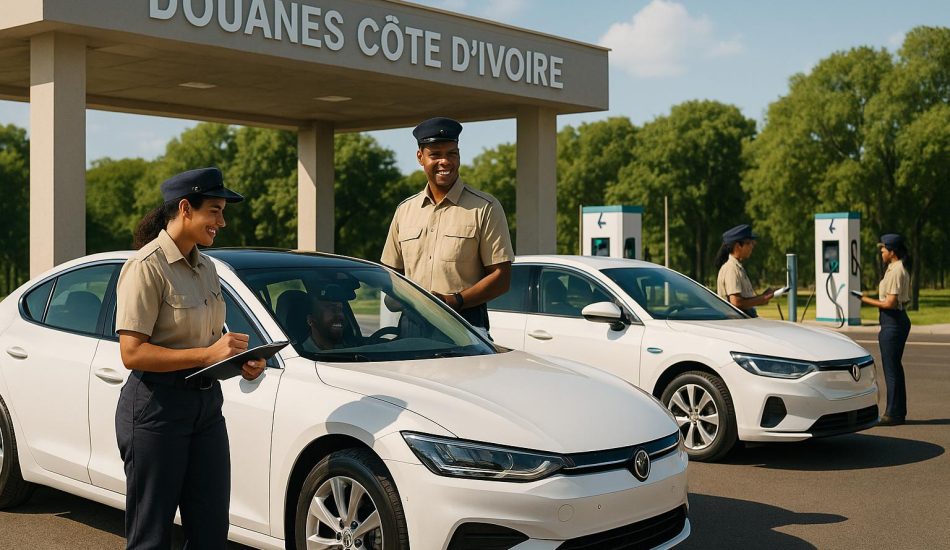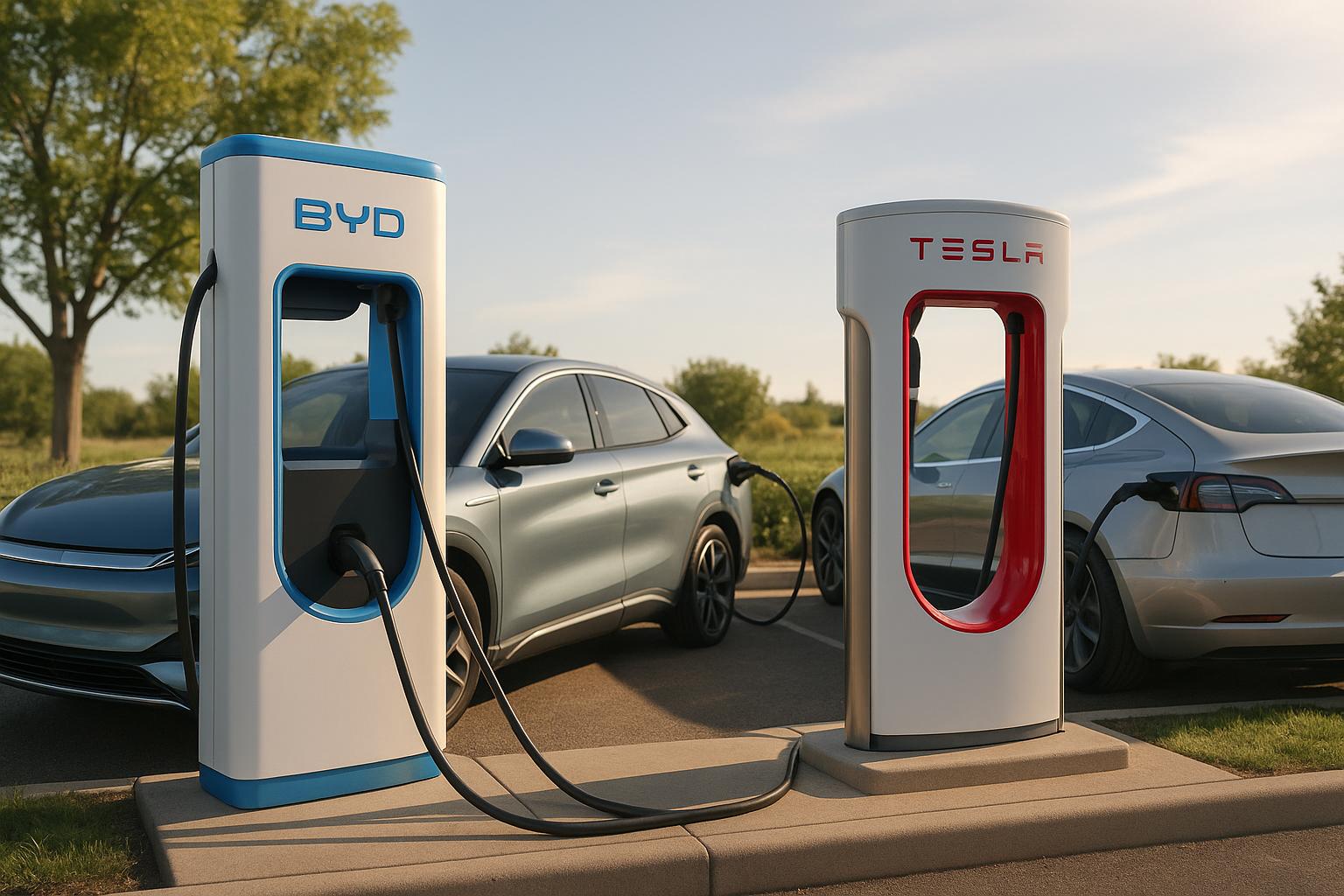
BYD and Tesla are advancing fast-charging technology, but their approaches differ. BYD’s latest system adds 250 miles in just 5 minutes, using a 1,000 kW charger and 1,500V silicon-carbide tech. Tesla’s Supercharger V4 adds 170 miles in 15 minutes, with plans for 350–500 kW upgrades. While BYD leads in speed, Tesla’s global Supercharger network (50,000+ stations) offers proven accessibility.
Fast charging is critical for EV adoption in Africa, where long distances and limited infrastructure pose challenges. BYD’s advanced systems excel in efficiency but require robust grids, which are scarce in many African regions. Tesla’s network, though limited in Africa, is expanding to support non-Tesla EVs.
Quick Comparison:
| Metric | BYD | Tesla |
|---|---|---|
| Max Power Output | 1,000 kW | 250–350 kW (planned 500 kW) |
| Range Added | 250 miles in 5 min | 170 miles in 15 min |
| Battery Voltage | 1,500V | 400V |
| Network Coverage | Limited (China-focused) | 50,000+ stations globally |
| Pricing (Entry Models) | ~$10,880 | Higher |
Africa faces obstacles like grid limitations and high installation costs, but platforms like EV24.africa simplify EV imports and promote adoption. BYD’s affordability and Tesla’s network reliability each offer distinct advantages, but both require significant infrastructure upgrades to fully realize their potential in the region.
We Tried BYD’s 5-Minute ‘Megawatt’ EV Charging In China – It’s Mind-Blowing
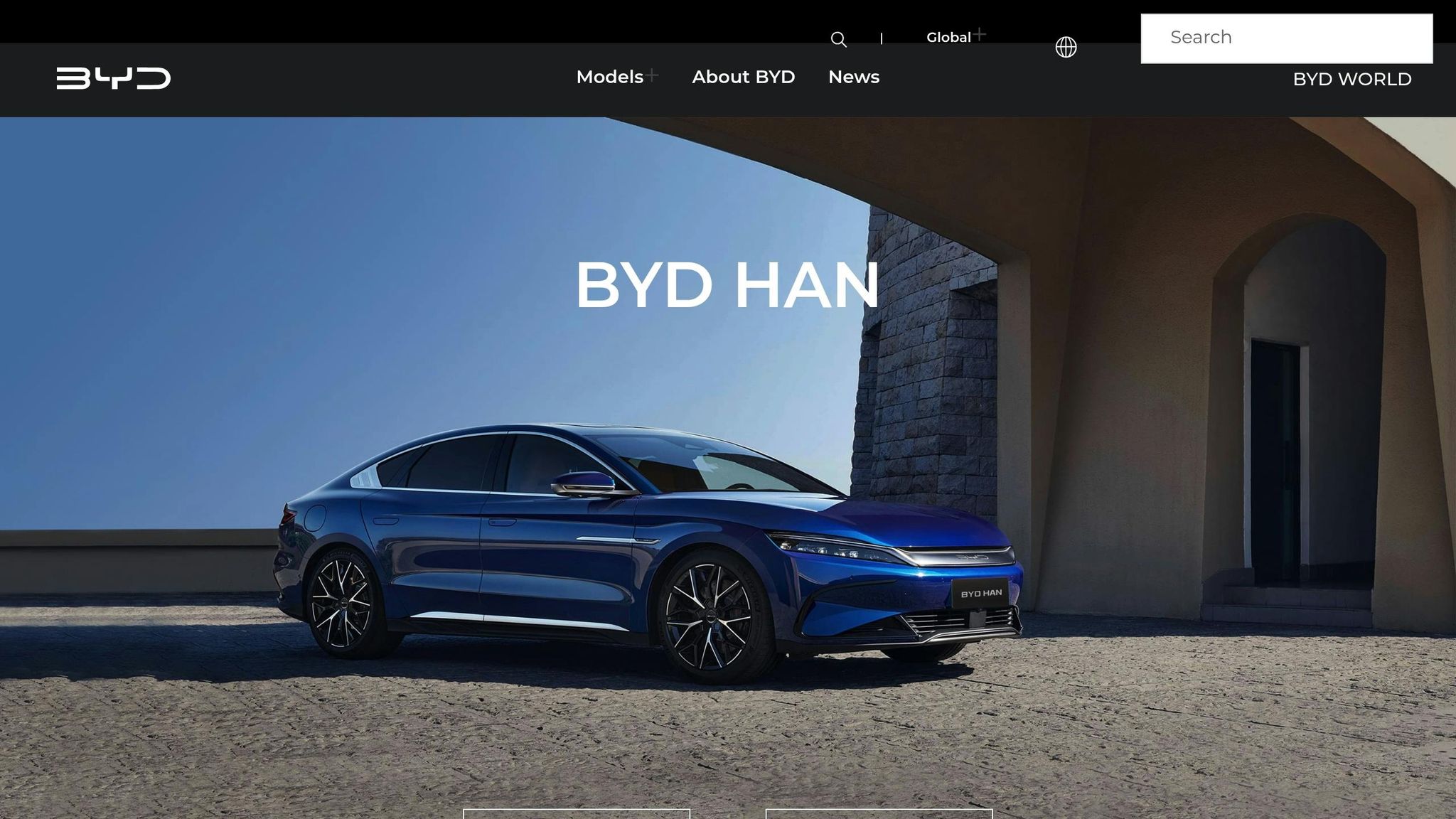
BYD Fast-Charging Technology
BYD is at the forefront of fast-charging advancements, thanks to three key innovations: a fully liquid-cooled megawatt flash charging terminal system, cutting-edge silicon carbide power chips, and flash-charging batteries equipped with ultra-fast ion channels. These technologies are integral to the impressive performance seen in BYD’s latest electric vehicles.
Key Features of BYD’s Fast-Charging Systems
The liquid-cooled megawatt flash charging terminal system delivers up to 1 megawatt (MW) of peak charging power. This liquid cooling system effectively manages heat, ensuring safe and consistent charging performance.
BYD’s silicon carbide (SiC) power chips are another standout feature. With a voltage rating of up to 1,500V – the highest in the automotive sector – these chips enable ultra-fast charging without sacrificing efficiency.
The flash-charging batteries reduce internal resistance by 50%, allowing for extremely rapid charging speeds. These batteries are paired with BYD’s Blade battery technology, which uses lithium iron phosphate (LFP) chemistry. This combination provides enhanced safety, longer battery life, and cost efficiency.
Thermal management is another area where BYD excels. The Blade battery generates only half as much heat per volume as Tesla’s 4680 cell when charging at the same rate. Additionally, the Blade battery achieves about €10/kWh lower material costs compared to Tesla’s 4680 cell, making it a practical choice for large-scale production.
Performance in BYD Vehicles
These innovations translate into impressive real-world performance for BYD’s vehicles. For instance, the BYD Han EV can gain a 400-kilometer (248-mile) range with just five minutes of charging, addressing concerns about range limitations.
Other models, like the BYD Seal and Atto 4, can charge from 10% to 80% in roughly 22–25 minutes. This timeframe is ideal for daily use, as charging speeds typically slow beyond 80% to preserve battery health.
The newly introduced BYD Han L and Tang L models feature the advanced Super e-Platform, incorporating the latest flash-charging batteries and SiC power chips. Currently in pre-sales in China, these vehicles showcase BYD’s most advanced charging capabilities.
Safety is also a priority. The Blade battery’s design minimizes the risk of thermal runaway, ensuring stable and secure operation even during rapid charging sessions.
While BYD’s high-voltage technology presents challenges for existing charging networks outside China, the company is actively expanding its global footprint. With new manufacturing facilities planned in Europe and infrastructure development underway in regions like Africa, BYD’s innovations could set new standards for fast charging worldwide.
Tesla Fast-Charging Technology
Tesla has built a reputation for its fast-charging capabilities, thanks to its global Supercharger network. Since its debut in 2012, this high-speed charging system has grown to include over 50,000 connectors worldwide, positioning Tesla as a leader in electric vehicle (EV) charging solutions.
Tesla Supercharger Network and Features
At the heart of Tesla’s fast-charging success are its V3 and V4 Superchargers. The V3 Superchargers currently deliver up to 250 kW of power, while the newer V4 models push the limit to an impressive 350 kW. To optimize efficiency, Tesla vehicles use an integrated thermal system that preconditions the battery during navigation, ensuring it reaches the ideal temperature for charging.
The V4 Superchargers also come with practical upgrades like longer cables and dual-voltage support, making them more versatile and ready for future Tesla models. Tesla has even launched pilot programs to allow certain non-Tesla EVs to use its network, reflecting the company’s efforts to expand accessibility. The charging system relies on the North American Charging Standard (NACS) connector, which Tesla has started sharing with other EV manufacturers through these initiatives. These advancements contribute to faster and more efficient charging experiences for drivers.
Performance of Tesla Models
Tesla’s vehicles consistently showcase impressive charging performance. For instance, a Tesla Model 3 with a 75 kWh battery can go from 10% to 80% charge in just 18–20 minutes using a V4 Supercharger. Meanwhile, V3 Superchargers can add 175–200 miles of range in about 15 minutes.
Tesla’s battery technology plays a critical role in enabling such speeds. The company uses advanced battery chemistries like NCA (Nickel Cobalt Aluminum) and LFP (Lithium Iron Phosphate), along with cutting-edge designs like the 4680 cylindrical cell. These innovations result in battery packs achieving energy densities of up to 241 Wh/kg, far surpassing competitors like BYD’s Blade battery, which sits at approximately 160 Wh/kg.
However, real-world charging speeds can vary based on factors like battery temperature, charger availability, battery age, and weather conditions. For example, colder temperatures can slow down charging, though Tesla’s preconditioning system helps counteract this issue.
In the U.S., Tesla’s Supercharger network offers competitive pricing, generally ranging from $0.25 to $0.50 per kWh. Payments are seamlessly handled through the Tesla app or the vehicle’s account, adding to the convenience.
Tesla’s combination of proprietary battery technology, advanced thermal management, and a well-established charging network provides an unmatched fast-charging experience. That said, coverage is still limited in certain areas. For example, in parts of Africa, platforms like EV24.africa are working to support Tesla vehicle imports, which could help drive EV adoption despite the current lack of charging infrastructure in those regions.
sbb-itb-99e19e3
BYD vs Tesla Fast-Charging Comparison
Now that we’ve looked at both technologies individually, let’s see how BYD and Tesla measure up when it comes to fast charging. This comparison highlights some key differences that affect both performance and ownership costs.
Performance Metrics
BYD’s latest fast-charging system is impressive, adding about 400 kilometers (roughly 250 miles) in just 5 minutes. Meanwhile, Tesla’s Supercharger V4 offers around 275 kilometers (170 miles) in 15 minutes. Tesla, however, has the advantage of proven real-world results, with charging from 10% to 80% typically taking 18–20 minutes. On the other hand, BYD’s system is currently limited to specific models and locations in China.
| Metric | BYD (Latest System) | Tesla Supercharger V4 |
|---|---|---|
| Maximum Power Output | Megawatt-level | Up to 350 kW |
| Range Added (Ideal) | 400 km in 5 minutes | 275 km in 15 minutes |
| Charging Speed | ~2 km per second | ~0.3 km per second |
| Real-World Performance | Limited data available | 18–20 min (10–80% charge) |
| Battery Architecture | 1,500V system | 400V system |
BYD’s 1,500V system, powered by silicon carbide chips, allows for more efficient energy transfer and generates less heat. Tesla’s 400V system, while reliable and widely used, doesn’t support the same theoretical charging speeds.
Cost Comparison
Cost is a major factor, especially for buyers in regions like Africa. BYD models, such as the YUAN PRO and DOLPHIN ACTIVE, are priced at approximately $10,880 and $11,800, respectively. Tesla vehicles, like the Model S, come with much higher price tags. Additionally, BYD’s Blade Battery technology, which reduces internal resistance by 50%, can lead to better efficiency and potentially lower charging costs over time. Tesla’s batteries, optimized for high energy density, may experience more wear with frequent fast charging, which could increase long-term costs.
Practicality and Usage
When it comes to real-world usability, the differences between these systems become clear. Tesla’s global Supercharger network boasts over 50,000 charging points and integrated payment systems, but in Africa, charging infrastructure is still in its early stages. BYD’s ultra-fast charging terminals are currently limited to certain areas in China, which means many BYD users may have to rely on third-party networks that don’t fully support the system’s capabilities.
Africa’s environmental challenges, such as high temperatures and inconsistent grid quality, make fast charging even more complex. BYD’s liquid-cooled system helps manage heat more effectively in hotter climates, while Tesla’s preconditioning system optimizes charging performance. However, extreme conditions can still affect both systems.
Another factor to consider is connector compatibility. Tesla often uses proprietary connectors or CCS2 standards, while BYD vehicles tend to support more widely-used standards that vary by region. Companies like EV24.africa aim to address these gaps by offering services such as import assistance, customs clearance, and local registration, making both BYD and Tesla vehicles more accessible across Africa’s 54 countries despite the infrastructure hurdles.
Availability and Infrastructure in Africa
Current State of Fast-Charging in Africa
Fast-charging infrastructure in Africa is still in its infancy. Tesla’s Supercharger network hasn’t reached the continent yet, and BYD’s ultra-fast charging systems remain exclusive to China. Across Africa, there are fewer than 1,000 public charging stations, most of which only offer slower AC charging. This lack of fast DC charging – critical for modern EVs – highlights the challenges of building a robust charging network in the region.
Currently, EV owners in Africa face charging times of 20–30 minutes to go from 10% to 80% battery capacity. This pales in comparison to the 5–15 minutes seen in more developed regions. Adding to the issue, regional grid limitations restrict the ability to support fast-charging systems effectively.
The technical requirements for fast-charging systems like those from BYD and Tesla further complicate their deployment in Africa. BYD’s system, for instance, relies on a 1,500V liquid-cooled terminal, while Tesla’s Superchargers demand compatible hardware and a grid capable of sustaining operations at up to 350 kW. Unfortunately, much of Africa’s grid infrastructure struggles with stability and capacity, making these systems difficult to implement without significant upgrades. On top of that, costs related to grid improvements, import tariffs, and the need for skilled local expertise drive up installation expenses.
How EV24.africa Facilitates EV Adoption
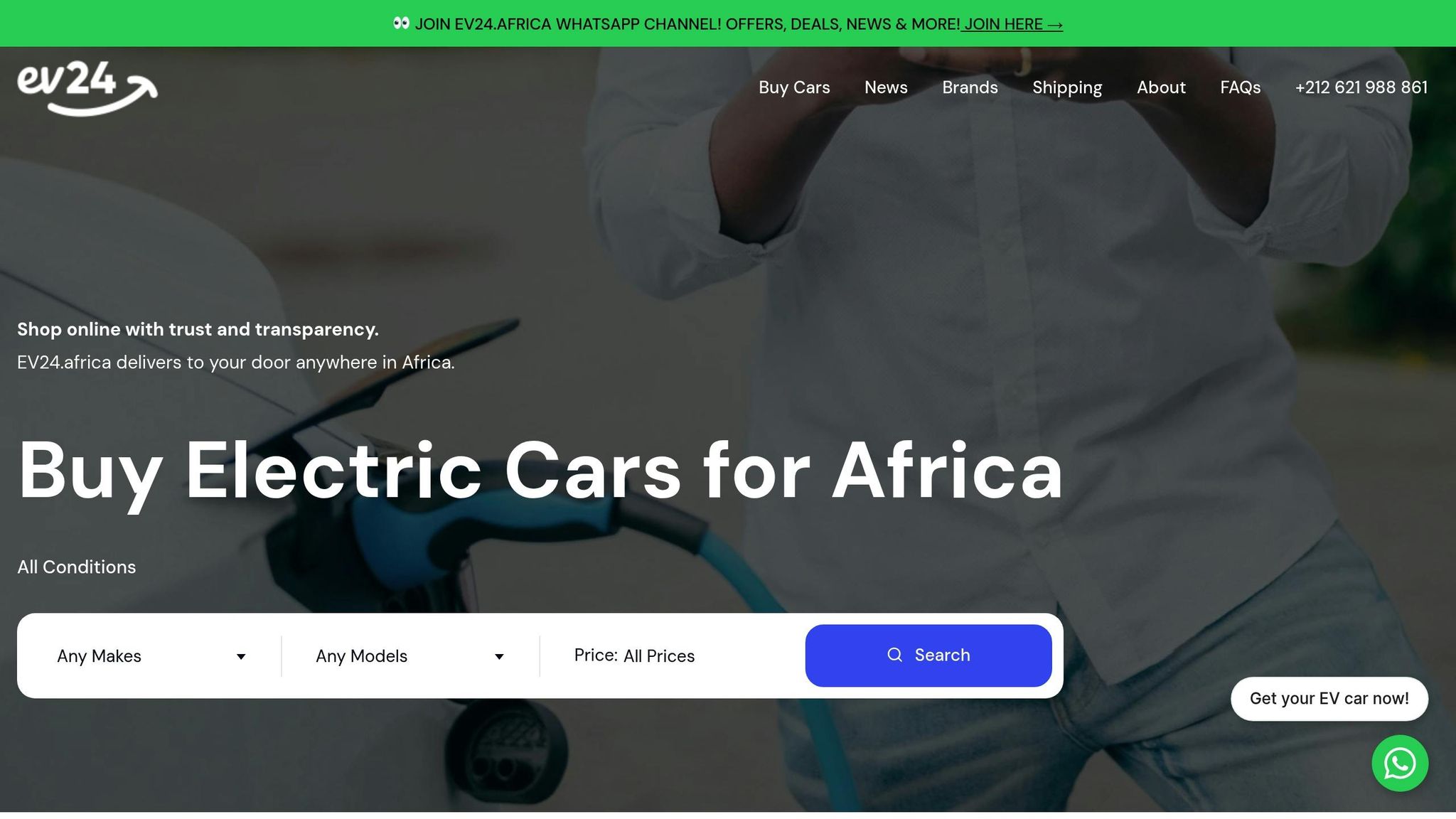
Given these hurdles, platforms that simplify the EV adoption process are crucial. One such platform, EV24.africa, plays a key role in making BYD and Tesla vehicles more accessible across the continent. It streamlines the import process, handling everything from customs clearance to local registration, which removes many of the barriers that potential EV owners face.
"At EV24.africa, we simplify the process of importing and buying electric vehicles in Africa. Our expertise ensures a seamless, transparent, and stress-free experience, so you can focus on driving the future of mobility."
- EV24.africa
EV24.africa doesn’t stop at vehicle sales. The platform also educates buyers about charging requirements and connects them with local service providers. While it doesn’t install charging infrastructure itself, its efforts to simplify logistics and promote EV ownership can help create the demand needed to justify investments in fast-charging networks. This is particularly important for urban areas and key transport routes, where such infrastructure is most urgently needed.
Conclusion and Key Takeaways
Key Points from the Comparison
BYD’s fast-charging technology delivers an impressive 400 km of range in just 5 minutes, outpacing Tesla’s 275 km in 15 minutes. Additionally, BYD’s more affordable models make this advanced charging capability accessible to a broader audience across Africa.
However, the lack of fast-charging infrastructure in Africa limits the immediate impact of these advancements. Systems like BYD’s all-liquid-cooled megawatt flash charging terminal and Tesla’s 350 kW charging capability demand more from local grids than they can currently handle. Without significant upgrades, these grid limitations restrict the actual speed improvements that these technologies could offer.
Future Outlook for Fast-Charging Technologies in Africa
The differences in performance and pricing highlight the potential evolution of Africa’s EV market. Urban areas and key transport routes are likely to see the first rollouts of ultra-fast charging stations. BYD’s combination of advanced technology and competitive pricing positions it as a strong contender for growth in the region. Meanwhile, Tesla’s global service network remains a valuable asset, even though its higher costs and limited Supercharger coverage in Africa could slow its adoption.
As EV adoption gains momentum, growing market demand is expected to encourage investments in charging infrastructure. Platforms like EV24.africa are playing a pivotal role by simplifying EV imports, offering transparent pricing, and connecting buyers with local services across all 54 African nations. These efforts help build the consumer base needed to justify the expansion of fast-charging networks.
With better grid capacity, supportive policies, and platforms like EV24.africa driving the transition, Africa could soon close the gap between cutting-edge EV technologies and the infrastructure needed to support them.
FAQs
What are the key differences between BYD and Tesla’s fast-charging technologies, especially in areas with limited grid capacity like Africa?
When it comes to fast-charging technologies, BYD and Tesla have taken distinct paths, especially when considering regions with limited grid capacity, like parts of Africa. Tesla’s Supercharger network is built around proprietary charging stations designed for ultra-fast charging. However, these stations often require robust grid infrastructure, which can be a hurdle in areas where power reliability is inconsistent.
On the other hand, BYD’s approach leans toward flexibility. Their charging solutions are often designed to work seamlessly with existing infrastructure, making them a practical option for regions facing grid constraints. This adaptability could give BYD an edge in areas where the power supply is less stable.
In places like Africa, where grid reliability varies, the availability of charging stations that can integrate with renewable energy sources becomes a key consideration. While both companies are pushing the boundaries of innovation, the decision between Tesla and BYD often hinges on the region’s specific energy and infrastructure requirements.
What are the long-term costs of using BYD and Tesla fast chargers, including effects on battery life and charging efficiency?
The long-term expenses tied to using BYD and Tesla fast-charging technologies hinge on factors like battery wear, charging efficiency, and electricity costs. Regular use of fast chargers can slightly accelerate battery aging due to the heat generated by high-power charging. That said, both BYD and Tesla have engineered their vehicles and charging systems to limit these effects and extend battery life as much as possible.
When it comes to charging efficiency, Tesla’s Supercharger network is often praised for its speed and dependability, which not only saves time but also reduces energy loss during charging. BYD’s fast-charging systems also deliver strong performance, though their availability may depend on where you are – especially if you’re in Africa. For EV owners in Africa, platforms like EV24.africa can be a valuable resource to explore electric vehicle options and learn more about the charging infrastructure in your region.
How does EV24.africa support the adoption of BYD and Tesla electric vehicles in Africa despite challenges with charging infrastructure?
EV24.africa simplifies the process of purchasing BYD and Tesla electric vehicles for buyers across Africa. They provide a wide range of electric cars, featuring models from Tesla and BYD, with transparent pricing and financing options tailored to various budgets.
On top of that, EV24.africa manages the entire logistics chain. This includes shipping, customs clearance, and local registration, ensuring hassle-free delivery to all 54 African countries. Their all-inclusive approach removes logistical challenges, making it easier for the region to embrace electric mobility.


